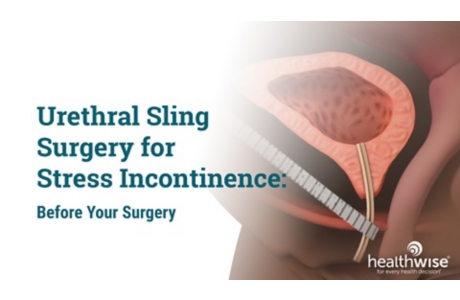Urethral Sling Surgery
Surgery Overview
Urethral sling surgery is done to treat stress incontinence. A sling is placed around the urethra to support it and help it retain urine. Your urethra is the tube that carries urine from the bladder to outside the body.
There are different types of urethral sling surgeries. The two main types of slings are midurethral and traditional. Midurethral slings are made out of synthetic mesh material. Traditional slings are made out of a strip of human or animal tissue.
You may be asleep during surgery. If you are awake, you will get medicine to prevent pain and help you relax.
To do the surgery, the doctor makes small cuts (incisions) in the vagina and lower belly or upper thigh. Then the doctor places a strip of mesh tape or tissue through the incisions and under your urethra like a sling or hammock. Then the incisions are closed with stitches.
You may go home the same day as your surgery. Or you may stay in the hospital overnight. You will probably be able to go back to work in 1 to 2 weeks. But you will need at least 6 weeks to fully recover before returning to all normal activities. You must avoid heavy lifting and strenuous activities during this time.
What To Expect
Usually a few hours after surgery, you will be asked to urinate to test how your bladder and urethra respond to the surgery. If you can't empty your bladder, you may need to have a thin, flexible tube (catheter) placed into your bladder through your urethra. You will have the catheter for a short time. It allows urine to drain while you recover. Or you may be taught to do self-catheterization for a while.
Depending on the surgery, you may be released to go home the same day. Some people have to stay in the hospital overnight. After you are at home, expect a 2- to 6-week recovery period. During this time, you will need to avoid heavy lifting and strenuous activities. Talk to your doctor about when you can return to work.
The amount of pain you have after surgery depends on the exact nature of your procedure, your physical condition at the time of surgery, and your own response to pain. You will probably feel some pain at the incision site and may feel some cramping in your abdomen. Your doctor may prescribe medicine to relieve your discomfort during the first few days after surgery. Be sure to call your doctor if you can't get relief from pain.
Why It Is Done
The urethral sling procedure may be used for women who have stress incontinence:
- Caused by sagging of the urethra and/or bladder neck.
- Caused by problems with the muscular outlet of the bladder (sphincter).
How Well It Works
Sling surgeries are as effective as other surgeries to cure stress urinary incontinence in women. About 8 out of 10 women are cured after this surgery.footnote 1
Risks
Some complications of urethral sling surgery include:
- Difficulty urinating after surgery.
- New symptoms of urgency or urge incontinence.
- Injury to an organ (such as the bladder, urethra, or ureters).
- Internal bleeding.
- Infection at the incision site.
All surgeries that use general anesthesia carry a small risk of complications or death.
Credits
Current as of: February 27, 2023
Author: Healthwise Staff
Clinical Review Board
All Healthwise education is reviewed by a team that includes physicians, nurses, advanced practitioners, registered dieticians, and other healthcare professionals.
Current as of: February 27, 2023
Author: Healthwise Staff
Clinical Review Board
All Healthwise education is reviewed by a team that includes physicians, nurses, advanced practitioners, registered dieticians, and other healthcare professionals.



